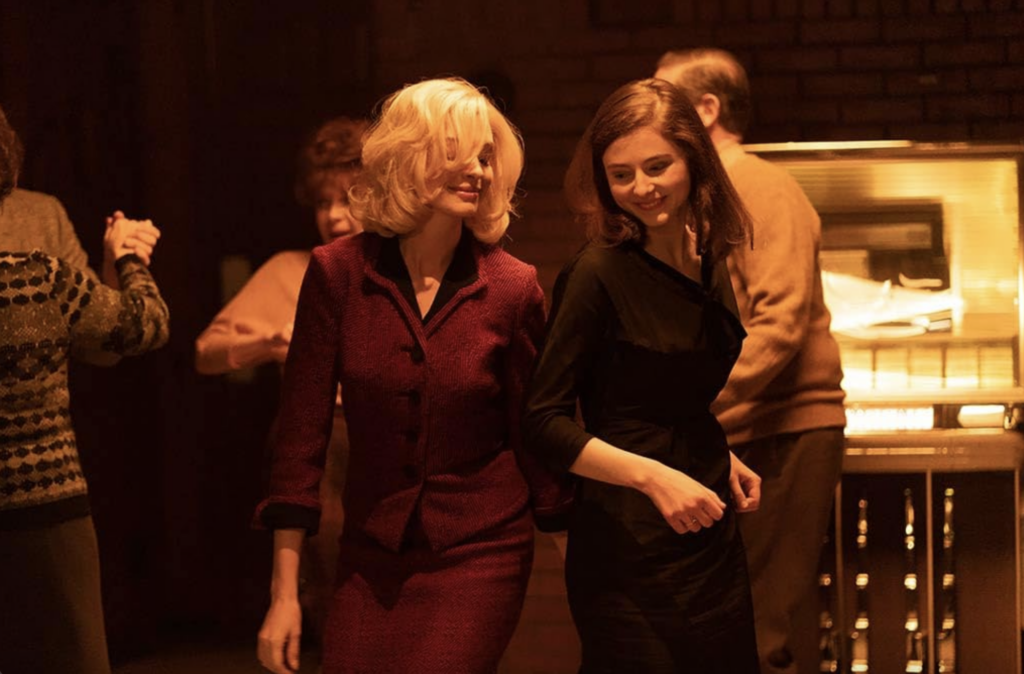
Romance remains a titillating and yet perpetually elusive notion. “Eileen,” adapted from Ottessa Moshfegh’s novel of the same name, juxtaposes the classic love-story structure seen in films like “La La Land,” “The Notebook” and “Brokeback Mountain” with a perplexing, jagged, nonlinear and unfortunately realistic emotional exchange.
Given the opportunity to hear from the filmmakers — director and producer William Oldroyd, co-writer and producer Ottessa Moshfegh and co-writer and producer Luke Goebel — I had high expectations when screening the film. In his directorial statement, Oldroyd emphasizes the group’s hopes to develop an elaborate and “participatory psychological thriller which keeps the audience guessing at every twist and turn.”
“Eileen” moves through a gloomy winter in the melancholic suburbs of 1960s Massachusetts. Serving almost as a secondary character, the film’s sullen setting reflects our titular character’s own life — capturing, as Moshfegh says, “an atmosphere, a time and a mood.” The grainy and shadowed filter applied to most of the film’s shots underscores how one’s mental state may change how they see the world.
Eileen (Thomasin McKenzie) feels like an outcast from society: uninteresting, invisible and unremarkable. She craves sex — though this reflects her deeper longing for affection, agency and power. Sex symbolizes freedom and the ability to be seen and walks on screen as a tall, gorgeous blonde named Rebecca (Anne Hathaway).
Rebecca presents herself as everything Eileen is not: a new hotshot psychiatrist at the prison where Eileen works as a secretary of sorts. Rebecca moves and eyes follow — Eileen’s included. Eileen envies Rebecca’s existence and falls into a deep obsession with her.
Rebecca shows a keen interest in Eileen while being equally distant — close enough to lure Eileen in and yet far enough away to enhance her fixation. In this way, the film touches upon many unique nuances of queer love. “We were all very interested in the gray area between platonic and romantic, real and imaginary; there were a lot of blurred lines and discomfort,” Moshfegh said. Eileen’s anxious tension influences and enhances the viewer’s experience.
I confess, this film seems to cover a small span of time, and I would claim that not much happens. The plot is, in my opinion, a vehicle to propel a much more significant character study. This film feels violating in the way audiences can resonate so deeply with Eileen. To some extent, we all want to be Rebecca and seek to reject our connections to Eileen.
Goebel shared a subtle distinction the filmmakers wished to make: “Confusion of infatuation is universal… whether this is love or lust or whether we just want to become that other person that we so admire and are so taken by.” The latter serves as a slippery gateway to self-depreciation and false refinement as Eileen intends to mimic another seemingly better person.
Moshfegh additionally stresses the importance of not projecting her character’s personalities onto ourselves: “Sometimes I worry about young people and young people who identify with being mentally unwell and the glamor associated with that,” Moshfegh said. Both Rebecca’s arc and the techniques used to film and create her illustrate the misleading notions that build her illusion of security and help emphasize the flaw of taking after her character.
Rebecca sports a bold voluminous blonde bob, and the camera is often positioned behind her, hiding her face and illuminating her hair. I remember remarking about how unnatural the hair looked on Hathaway and how obviously fake it was. I soon formed my own interpretation of this detail — Hathaway is not blonde; Rebecca is not real — a notion Oldroyd welcomes. “I like the fact that people are opening their minds,” Oldroyd said. As Rebecca falls apart, her persona does too, and we are reminded that we must be content with ourselves, not others’ image of us.
My only gripe with this film regards Eileen’s lack of depth. Eileen is a generally silent character, and while McKenzie does a phenomenal job depicting the variety of emotions Eileen endures, I would love more insight into her inner nature.
According to Moshfegh, this change results from the need to condense the novel’s plot. “In the novel, there’s about half a book about Eileen and her life before she meets Rebecca, and it’s all basically exposition,” Moshfegh said. “But when you’re storytelling on screen you don’t really have that much room to develop a character.”
Goebel specified the team’s desire to avoid including voiceovers meant to imitate the novel, fearing it would return a disappointing result: Eileen’s silence, they said, signifies her repression and oppression from society and enabled them to better depict Rebecca’s sharp contrast to the title character. Regardless, I’d still argue that Eileen’s character would be elevated if we’d been given more substance to explore her psyche.
Nevertheless, Eileen is beguiling, dangerous and contemporary — I absolutely recommend this film.














